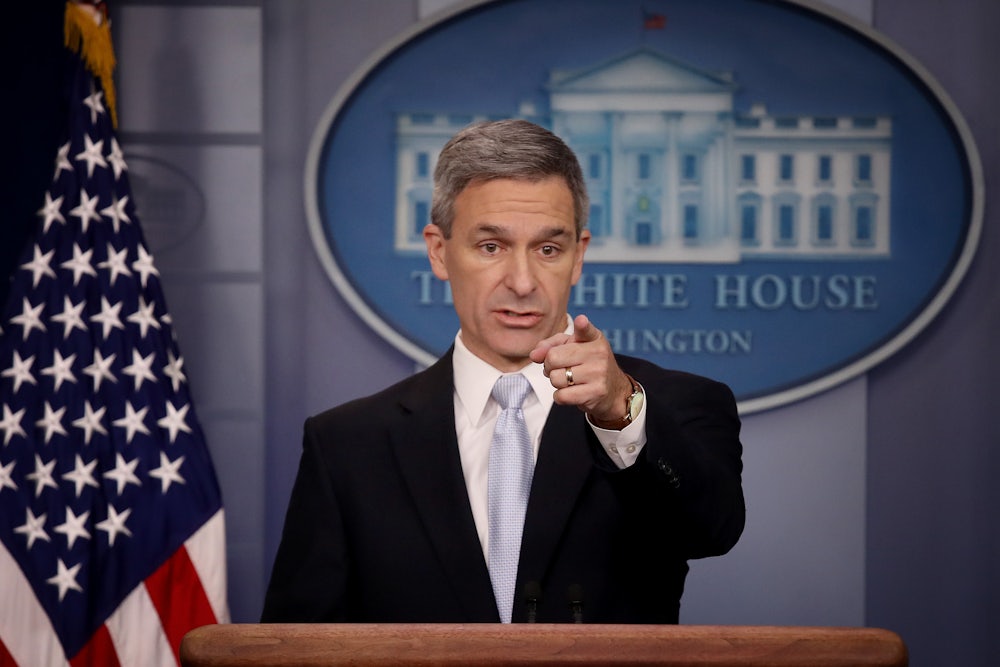Donald Trump’s top immigration official tried his hand at poetry Tuesday, revamping “The New Colossus”—the Emma Lazarus sonnet immortalized inside the pedestal of the Statue of Liberty—to fit the administration’s nativist policies. Asked by NPR if the Lazarus poem—which includes the famous lines “Give me your tired, your poor, / Your huddled masses yearning to breathe free, / The wretched refuse of your teeming shore”—is still part of the “American ethos,” Ken Cuccinelli shrugged off the question. “They certainly are,” Cuccinelli said. “Give me your tired and your poor—who can stand on their own two feet and who will not become a public charge.”
As poetry, it certainly doesn’t compare to Lazarus’s soaring imagery, nor her comforting intent—though that isn’t much of a surprise given Cuccinelli’s history. (In 2012, while serving as Virginia’s attorney general, he compared immigrants to animals. “[The D.C. wildlife protection policy] is worse than our immigration policy—you can’t break up rat families. Or raccoons or all the rest and you can’t even kill them,” Cuccinelli said. “It’s unbelievable.”) On Monday, Cuccinelli cited Lazarus’s poem while unveiling one of the Trump administration’s most aggressive efforts yet to curb legal immigration.
The plan, based on a nineteenth century (and never formalized) “public charge” principle, could deny green cards and citizenship to immigrants who have used public services like Medicaid, SNAP (food stamps), or the Children’s Health Insurance Program, or to those deemed “likely” to use them in the future. Per The Washington Post:
Factors that can count against a green card applicant include having “a medical condition” that will interfere with work or school; not having enough money to cover “any reasonably foreseeable medical costs” related to such a medical condition; having “financial liabilities;” having been approved to receive a public benefit, even if the individual has not actually received the benefit; having a low credit score; the absence of private health insurance; the absence of a college degree; not having the English language skills “sufficient to enter the job market;” or having a sponsor who is “unlikely” to provide financial support.
The administration has been planning to implement these measures since last year. In Monday’s press conference, Cuccinelli stressed that the plan was meant to foster “self-reliance” among immigrants. But the likely effect is to discourage immigrants who might need public services from seeking them, for fear it could damage their chances for residence status or naturalization.
It’s also another sign of the administration struggling to thread a needle in its approach to immigration policy. The hardliners in the administration, like Cuccinelli and Senior Adviser Stephen Miller, are finally moving past the focus on illegal immigration, to enshrine curbs on legal immigration—something that has been their ultimate goal since this administration’s earliest days. But this White House is also attempting to assuage business interests by claiming to advance “merit-based” immigration, particularly H-1B visas, which are favored by many industries, most notably the tech sector.
To an extent, this approach is emblematic of an administration that has attempted to advance Trump’s populist, xenophobic rhetoric while also sticking to a swamp-standard pro-business, anti-regulation Republican agenda. By signaling that the huddled masses are no longer welcome while others in the administration (particularly Jared Kushner) continue to advocate for the types of visas favored in Silicon Valley, Team Trump spins this as advocating not for “zero immigration,” but for the “right kind of immigration.” Which might be radically antithetical to the ideals behind the lady in the harbor, but it’s still a fairly typical right-wing approach.
Some with ties to the administration have gone even further, arguing that all types of legal immigration should be curbed. Steve Bannon suspended the expedited processing of H-1B visas shortly after Trump entered the White House. Though now largely irrelevant, Bannon continues to advocate for dramatically curbing immigration of skilled workers, particularly in technology industries—an idea that seemingly runs counter to Trump’s “merit based” policy for elevating elite immigrants.
And yet, the dissonance persists. As Recode’s Rani Molla wrote earlier this year, “Using executive orders, the president has made it more difficult—and expensive—to hire high-skilled tech workers from other countries. The administration has throttled a program that encouraged entrepreneurs to come to the U.S. It’s also ending work permits for spouses of H-1B holders, who are often highly skilled professionals themselves.” As a result of the administration’s efforts, there was a 10 percent decline in H-1Bs issued last year.
Still, the administration appears to be doing what it can to curb all immigration, legal or otherwise, while trying not to upset key economic stakeholders. The result: An immigration policy that is both draconian and incoherent. Key administration figures might, at times, try to impose some pseudo-intellectual rigor on their pretzel logic, but the real message remains. It isn’t just about dissuading the tired and poor from coming, it’s about telling everyone to stay away.
